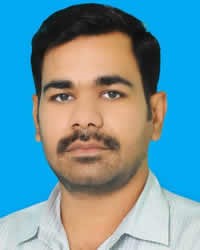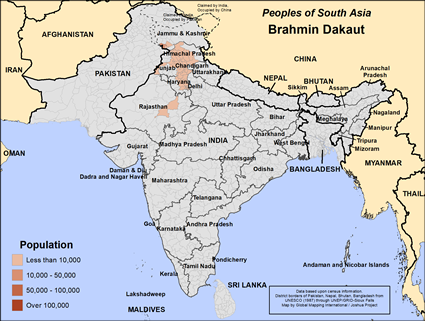Brahmin Dakaut in India

Photo Source:
Anonymous
|

Map Source:
People Group data: Omid. Map geography: UNESCO / GMI. Map Design: Joshua Project.
|
| People Name: | Brahmin Dakaut |
| Country: | India |
| 10/40 Window: | Yes |
| Population: | 75,000 |
| World Population: | 75,000 |
| Primary Language: | Hindi |
| Primary Religion: | Hinduism |
| Christian Adherents: | 0.00 % |
| Evangelicals: | 0.00 % |
| Scripture: | Complete Bible |
| Ministry Resources: | Yes |
| Jesus Film: | Yes |
| Audio Recordings: | Yes |
| People Cluster: | South Asia Forward Caste - Brahmin |
| Affinity Bloc: | South Asian Peoples |
| Progress Level: |
|
Introduction / History
The Dakaut Brahmins are fortune tellers, so they are only obliquely associated with the Hindu religious system. Some people question whether they should be considered Brahmin at all. Since they are classified as Brahmins, we will offer some general comments.
Brahmins are the highest of the four varna (major caste groupings) in Hinduism. The historical developments of various Brahmin castes are not clear, as the history of the caste system itself is unclear. There was perhaps a caste system based on personal merit at one time before the hereditary caste system became dominant, as is seen in modern history. Brahmin castes became powerful in the early centuries of the Christian Era through alliances with kings, who granted them landed estates related to temples and temple service. There has never been a comprehensive analysis of all the different types and subgroups of Brahmins.
Traditionally Brahmins have five daily duties; to the gods, to ancestors, to all creatures, to humans, and to study. Thus daily worship (duty to gods) and chanting of sacred texts (duty to study) are an integral part of many Brahmins' lives, even if this is only a token routine for many.
Where Are they Located?
Dakaut Brahmins are a small community located in India's northern states of Haryana, Uttar Pradesh, Himachal Pradesh, Rajasthan, and Punjab. Most of them speak the local language and English since higher education in India is mostly English medium.
What Are Their Lives Like?
Brahmins are still deeply influenced by the traditional four stages of life; the first student stage is followed by the householder stage, where marriage, raising a family and being a productive member of society is the primary obligation of an individual. Once children are married there is time for spiritual concerns in the third stage of reclusiveness.
What Are Their Beliefs?
In some cases Brahmin subgroups are defined by their theological distinctions such as Madhva Brahmins, who are defined by their dualist theology, though everyone does not actually hold those beliefs. However, many Brahmin castes are made up of people who adhere to all the various philosophical and theological options espoused by modern Hindus, including hard core secularists and atheists. One can never predict what an individual Brahmin might believe or disbelieve!
What Are Their Needs?
Brahmins as an influential and generally well-to-do community are not unlike the middle classes of most places. Their main needs involve relational strains that are usually kept behind closed doors. Modernization is breaking down family units which have been the glue to society for many generations, and loneliness is increasingly a problem. They are expected to "achieve it all," but ironically, achieving it all can be empty.
Prayer Points
Pray for Christ to reveal Himself to Dakaut Brahmin leaders.
Pray for the eyes of Brahmin hearts to be open to Jesus Christ as Lord and king.
Pray for Holy Spirit directed Christ followers to go to Dakaut Brahmin communities.
Pray for a disciple making movement to emerge among every Brahmin community.
Pray for many to be prompted to faithfully pray for Brahmins.